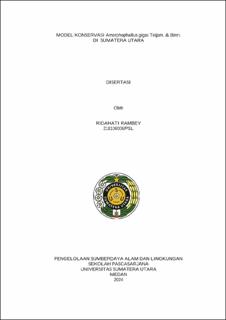Model Konservasi Amorphophallus gigas Teijsm. & Binn. di Sumatera Utara
Conservation Model of Amorphophallus gigas Teijsm. & Binn in North Sumatra

Date
2024Author
Rambey, Ridahati
Advisor(s)
Rahmawaty
Rauf, Abdul
Nababan, Esther Sorta Mauli
Metadata
Show full item recordAbstract
Amorphophallus gigas is a wild-growing species of Amorphophallus found in various regions of North Sumatra and is recognized as part of a plant group producing the tallest flowers in the world. Amorphophallus species also produce tubers rich in glucomannan, a compound with medicinal benefits for humans. However, empirical studies on the population status and distribution of A. gigas, particularly in North Sumatra, remain limited. This has resulted in suboptimal conservation efforts for both the species and its habitat. This research aims to: (1) Assess the habitat suitability of A. gigas and construct spatial maps using MaxEnt analysis, (2) Determine the land suitability characteristics of A. gigas in North Sumatra using the Matching method, (3) Analyze the population structure and association of A. gigas with other wild plants, (4) Construct a morphological phylogenetic dendrogram of A. gigas accessions from North Sumatra using the NTSYSpc software, (5) Identify the roles of various Actors in A. gigas conservation using the MACTOR software, and (6) Develop a dynamic conservation model for A. gigas in North Sumatra. The methods employed in this study include collecting geographic coordinates, analyzing soil physical and chemical properties, matching land suitability, identifying key cctors in A. gigas conservation, and identifying important variables for building the conservation model. The habitat distribution of A. gigas in North Sumatra includes the districts of South Labuhanbatu, North Padang Lawas, South Tapanuli, North Tapanuli, and Mandailing Natal. Generally, A. gigas grows wild under agroforestry systems, including rubber, durian, and incense tree plantations. The population of A. gigas varies across locations, with differing numbers of individuals recorded. For example, at an altitude of 0–200 meters above sea level (m.a.s.l.) in Sabungan, 98 vegetative and 2 generative individuals were identified. At an altitude of 800-1,000 m.a.s.l., populations included 138 vegetative individuals in Simasom, 132 in Pancur Napitu, and 17 in Jukkihan. An analysis of the key Actors in A. gigas conservation revealed that farmers, village governments, farming groups, local traders, the Natural Resources Conservation Agency, NGOs, academics, provincial-level traders, factories, and exporters play important roles. Farmers, though directly involved with A. gigas, have a weak role in decision-making processes. The BKSDA has the most influence, while farmers exhibit the highest dependence on the system. The dynamic conservation model for A. gigas emphasizes balancing the three pillars of conservation namely protection, preservation, and sustainable utilization.
